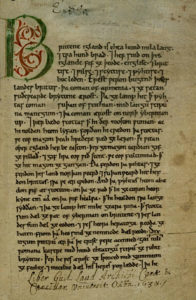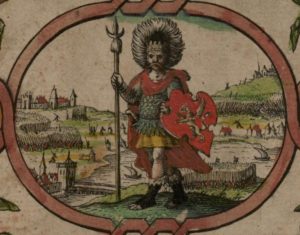The first king of the kingdom of Wessex, and certainly one of the most interesting of its kings, was a man known as Cerdic. A considerable amount of speculation has been made concerning who this man really was, where he came from, and how he may relate to the Arthurian legends.
Overview
 The primary source for Cerdic of Wessex is the Anglo-Saxon Chronicle (ASC). To give a brief summary, this document reports that Cerdic came to Britain with his son Cynric in 495, landing in Hampshire. At this point, they are both described as ‘ealdormen’, showing that they were not yet kings.
The primary source for Cerdic of Wessex is the Anglo-Saxon Chronicle (ASC). To give a brief summary, this document reports that Cerdic came to Britain with his son Cynric in 495, landing in Hampshire. At this point, they are both described as ‘ealdormen’, showing that they were not yet kings.
They next appear in the chronicle in 508, where they are described as fighting and defeating a British king named Natanleod, along with 5000 of his men. This took place at ‘Natanleaga’, generally identified today with Netley Marsh. This was also in Hampshire, quite near the coast, so apparently they had not yet progressed very far through the country by this point.
In 519, Cerdic is described as ‘obtaining the kingdom of the West Saxons’, so this year, supposedly, marks the start of the West Saxon kingdom.
By the year 527, it appears that Cerdic had made significant progress through the country, for he is described as fighting the Britons at ‘Cerdices Leah’, which is generally held to be Bernwood Forest, as far north as Buckinghamshire. In the next entry, we find the opposite extreme, for Cerdic and his son are said to have conquered the Isle of Wight, south of Hampshire.
Finally, in 534, Cerdic’s death is recorded, and the kingdom passed to his son Cynric. His dynasty, so the records claim, produced almost all of the subsequent kings of England until the time of William the Conqueror.
So, already we can see that he seems to have been a very significant personage. Provided that he was real, which most scholars accept him as being, we can say that if he had never come to Britain, the history of the country would likely have looked very different – at least the period up until William the Conqueror. Paradoxically, though, we know very little for certain about this significant individual. There are numerous question marks surrounding his life, so let us have a look at some of them.
When Did He Live?
 On the face of it, the question of when Cerdic lived seems to have a straightforward answer. After all, the ASC records him as arriving in Britain in 495 and dying in 534. However, scholars have noted that the chronology of the ASC seems confused for this period. One reason is that several of the events concerning the West Saxon kingdom seem to be duplicated by exactly 19 years. Apparently this is due to the astronomical cycle that was used to date the events in the chronicle, which cycle repeats every 19 years.
On the face of it, the question of when Cerdic lived seems to have a straightforward answer. After all, the ASC records him as arriving in Britain in 495 and dying in 534. However, scholars have noted that the chronology of the ASC seems confused for this period. One reason is that several of the events concerning the West Saxon kingdom seem to be duplicated by exactly 19 years. Apparently this is due to the astronomical cycle that was used to date the events in the chronicle, which cycle repeats every 19 years.
For example, Cerdic and Cynric, the founders of the West Saxon kingdom, are said to have arrived in Britain in 495. Yet, in 514 (exactly 19 years later), the ASC states that ‘this year the West-Saxons arrived in Britain’. Partly on this basis, it has been suggested that the events concerning Cerdic have been backdated by 19 years. The regnal years of the kings of Wessex, when working backwards from more secure dates, seem to confirm this conclusion. Thus, it may well be that Cerdic’s reign actually lasted from 534 to 553, instead of 519 to 534.
Was He Really a Saxon?
 Although it is most natural to assume that Cerdic was a Saxon, given that the ASC portrays him as fighting against the native Britons and founding the kingdom later known as the kingdom of the West Saxons, there are a number of scholars who have concluded that he was, in fact, a Briton. The most obvious reason for this is the fact that his name was actually British. ‘Cerdic’ is a variant form of ‘Ceredic’ or ‘Caradoc’, the name of quite a few British individuals from around this time. For example, there was a king of the Britons named Ceredic around the turn of the seventh century.
Although it is most natural to assume that Cerdic was a Saxon, given that the ASC portrays him as fighting against the native Britons and founding the kingdom later known as the kingdom of the West Saxons, there are a number of scholars who have concluded that he was, in fact, a Briton. The most obvious reason for this is the fact that his name was actually British. ‘Cerdic’ is a variant form of ‘Ceredic’ or ‘Caradoc’, the name of quite a few British individuals from around this time. For example, there was a king of the Britons named Ceredic around the turn of the seventh century.
There are also quite a few descendants of his whose names are apparently British in origin, such as Cedda and Cædwalla. This indicates that Cerdic’s apparently British name is not a coincidence. Could it be that he was actually a Briton who perhaps allied himself with the Anglo-Saxons, or whose dynasty came to be Anglicised over the years?
While this is a possibility, this conclusion is fundamentally rooted in a simplistic understanding of the political situation of post-Roman Britain. It is not the case that the Saxons wiped out the native population as they progressed through the country. This is confirmed by archaeology and genetic studies. While the Saxons definitely gained power over the natives (as confirmed by the contemporary Gallic Chronicle of 452), it is clear that the two groups intermingled within those areas where the Saxons had gained power.
One piece of evidence of this is the fact that genetic studies have revealed that the current distribution of the population of Britain largely conforms to the ancient, pre-Saxon-era distribution of tribes. Thus, it is clear that the Saxon invasion did not cause a wholesale removal of the native population. It was not a strict case of Saxons against Britons, at least in terms of ethnicity.
When this situation is understood, there is really no reason to think it peculiar that Cerdic, this supposedly Saxon leader, had a British name. The migration of Saxons to Britain had already been taking place for many decades before Cerdic appears in the ASC, so he could easily have been from a Saxon family that had intermarried with the locals one or more generations previously.
Of course, we are not saying that he could not have been a Briton. But the fact that he possessed an apparently British name (along with several of his descendants) is not nearly as significant as is commonly claimed, when the genuine political situation of Britain at that time is properly understood.
But if we entertain the possibility that he really was a Briton, then this opens up the way to identifying him with a number of Arthurian figures who are generally understood to be British. Let us now take a look at two of these.
Caradoc Vreichvras?
 One of Arthur’s Knights of the Round Table was a man named Caradoc Vreichvras. He appears in many different forms in the legends, and there may well have been multiple different people living in Arthur’s time with this name, causing some confusion in the records.
One of Arthur’s Knights of the Round Table was a man named Caradoc Vreichvras. He appears in many different forms in the legends, and there may well have been multiple different people living in Arthur’s time with this name, causing some confusion in the records.
In any case, Caradoc Vreichvras was one of Arthur’s main allies, being the ‘chief elder’, according to the Triads, of Arthur’s court at Celliwig in Kernyw. Whether this ‘Kernyw’ was Cornwall, as is commonly believed, or one of several places in Wales known by that name is uncertain. However, the article ‘Was King Arthur Welsh?‘ highlights some evidence that the Kernyw in which Celliwig was located was the historic region of Gwent known by that name.
This possibility is strengthened by the fact that Caradoc Vreichvras is generally considered to be identical to the probably-historical Caradoc ap Ynyr, an alleged king of Gwent around the turn of the sixth century. It would be most natural to assume that the place over which he was chief elder was at least close to the area in which he lived, which would thus indicate that Celliwig was in or near Gwent.
If so, then it is intriguing to note how close Cerdic’s ‘West Saxon’ kingdom was to the kingdom of Gwent. Could it be that Cerdic was actually identical to Caradoc the king of Gwent, Arthur’s chief elder at Celliwig?
Given that the ASC clearly records Cerdic as persistently fighting against the Britons through his career, it seems very unlikely that Cerdic could have been Arthur’s ally. And this is regardless of whether Cerdic was originally British or not. Furthermore, the geographical proximity between Gwent and Wessex is not particularly applicable in this early era of the Wessex kingdom.
King Arthur?
An even more incredible theory is that Cerdic of Wessex was actually Arthur himself. This is really an extension of the previous theory, for it is based on perceived similarities between Arthur and Caradoc Vreichvras. It is a theory that was developed by John C. Rudmin and Joseph W. Rudmin. Here are some of the similarities they point to:
- Arthur was illegitimate – Caradoc was illegitimate.
- Arthur’s mother was the wife of Gorlois (suggested to mean ‘Guor Elessa’) – Cerdic’s father was Elessa
- Arthur married Guinevere of Cornwall – Caradoc married Guignier of Cornwall
- Arthur was traditionally associated with Winchester, in Hampshire – Cerdic was the ruler of Hampshire
While some of their similarities seem legitimate (such as the third), most of the similarities they point to are either generic (such as the first), quite a stretch (the second), or are based on very late sources rather than the earliest information (the fourth). The two theorists liked to emphasize the supposed fact that Arthur and Cerdic are both said to have ruled the area of Wessex at the same time, but this is not where the earliest information places Arthur. While they may have ruled fairly close to each other, their territories were definitely distinct. In addition, the fact that Cerdic is described as an enemy to the Britons is not a fact that can just be dismissed.
However, these last two facts – that Cerdic and Arthur likely ruled close to each other and that Cerdic was an enemy of the Britons – does point us toward another Arthurian figure who may be identical to Cerdic.
Cheldric
Given that Cerdic fought against the Britons and was active very close to where Arthur was based, it is very likely that the two men would have crossed swords. In fact, this may be confirmed by the name of one of Arthur’s three main Saxon enemies in Geoffrey of Monmouth’s Historia Regum Britanniae: Cheldric. While this name is not identical to ‘Cerdic’, it is very similar, and it must be viewed in light of some of the other changes in spelling that Geoffrey made (such as turning the Welsh ‘Arawn’ into ‘Augusel’).
A number of researchers have accepted the identification of Cerdic with Cheldric, such as Frank D. Reno. In contrast to the previous two proposed identifications, this one matches the fact that Cerdic is shown to have been fighting against the Britons. Additionally, although the chronology and pattern of events do not perfectly line up between the HRB and the ASC, Cheldric is nonetheless described as gaining control of Dorset and Wiltshire, which would place him very close to where the ASC places Cerdic.
The only serious problem to this identification is the fact that Cerdic died, according to the ASC, in 534. In contrast, Cheldric was said to have died in the immediate aftermath of the Battle of Badon, which is generally placed in the first quarter of the sixth century. And when we also take into consideration the chronological adjustment that places Cerdic’s death in 553, the difference is even greater.
Unless the Battle of Badon actually took place much later than is commonly accepted, which some researchers do argue for, it seems that Cheldric cannot really have been Cerdic of Wessex. This is a frustrating conundrum, for the two characters do seem very similar, and Cerdic would otherwise be a perfect fit for Arthur’s Saxon enemy. Perhaps the Battle of Badon did take place much later than commonly believed, or maybe Cerdic’s life should actually be pushed backwards instead of forwards.
Final Words
It appears that it is impossible to conclusively identify Cerdic of Wessex with any Arthurian character, despite there being a few distinct possibilities. Nonetheless, Cerdic definitely left his mark on the historical record, being the founder of one of the most important kingdoms in early English history.


Cerdic fighting the Britons does not exclude him from being a Celtic Briton as there are many instances of internecine warfare amongst the Celts and the enlistment of Saxon mercenaries was common so there is nothing to say against Cerdic being a renegade Briton carving out a kingdom for himself with Saxon backing.